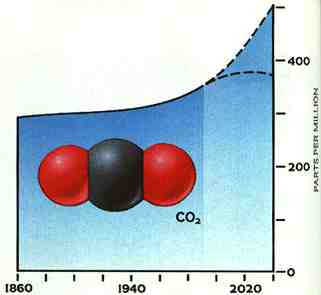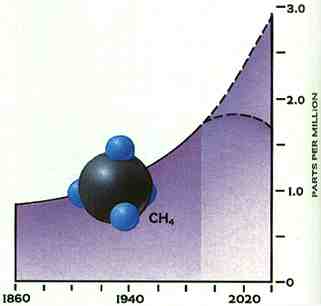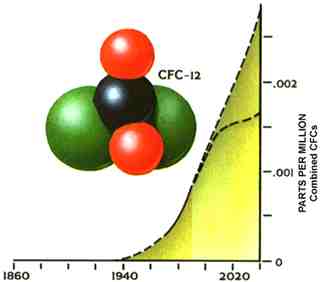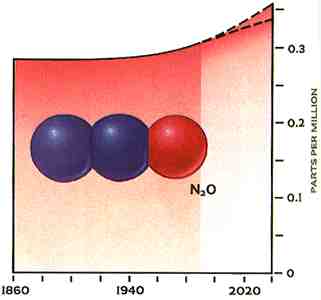



(click to enlarge)
FORETELLING WHAT MAY HAPPEN to the world if it should warm by even one or two degrees is the tough- est problem facing climatologists today. Even though there have been times in the dim geologic past when temperatures were warmer — with no ice at all on the polar regions — there are vast differences today. No one knows whether the "wild card" of human activity will disrupt or make more extreme the cycles ordained by nature.
To try to predict the effects of human intervention, scientists mathematically simulate the weather systems of the globe. Their equations, called general circulation models (GCMs), are so complex that only a few of today's supercomputers can solve them. The equations relate such things as the balance of radiation to and from the planet, air circulation, evaporation and rainfall, ice cover, sea-surface temperature – then try to assess what might happen if the sun were to become brighter by a tiny amount or if the carbon dioxide in the atmosphere gradually doubles as expected. The computers then calculate and map the changes in the weather of future days, weeks, seasons – or centuries.
One key to their accuracy lies in how finely they divide the planet's surface, the blanket of the atmosphere, and the seas. Most now divide the globe into blocks of at least five degrees of latitude and five of longitude: 300 nautical miles on a side, roughly the size and shape of Colorado. The best models then divide the atmosphere into as many as 20 layers and add in the oceans' currents and multiple layers. The computations are so formidable that a supercomputer might take a week to run a single change of input to determine its effect.
ON A HIGH SHELF of Colorado's Front Range, where deer roam in the open above the university town of Boulder stand the sand-hued buildings of the National Center for Atmospheric Research (NCAR), one of the principal climate-modelling centers in the nation. The others are NASA's Goddard Institute for Space Studies (GISS) on upper Broadway in New York City and NOAA's Geophysical Fluid Dynamics Laboratory (GFDL) in Princeton, New Jersey. The computer room at NCAR, its floor carpeted with bright red squares, is a futuristic assemblage of multicolored cabinets, computer terminals, and blinking panels of lights. The chief of the center, Bill Buzbee, showed me two red-and-black cylinders, each about five feet in diameter and five feet high, with segments seemingly cut out of them like huge wedges of cheese. "Those are our Cray supercomputers," Bill said. "Not many exist in the world. If you'd like to buy one, it might cost you about 20 million bucks. And it would not be powerful enough for much of the modeling we're asked to do."
"If our global grid were reduced to two and a half degrees on a side and the number of vertical layers increased," I had heard Jerry Mahlman, director of GFDL, say, "it would multiply the demand on the computer 16-fold; at one degree square, which might be necessary to forecast weather and climate accurately for local regions on the globe, the order of complexity -- and computer time -- would go up at least 500 times."
I began to appreciate what these machines do. They reduce inconceivably complicated systems of the atmosphere and oceans to logical, mathematical predictions of what might happen if man or nature changes the ways things are with the world. All the most advanced GCMs, fed a doubling of carbon dioxide, come up with similar results: The world will warm by the middle of the next century by two to five degrees Celsius -- three to nine degrees Fahrenheit -- with even greater warming in the subpolar latitudes. The differences between the models show up in regional effects (maps, pages 82-3): exactly where drying or more rainfall may occur, whether the Northern and Southern Hemispheres may react differently.
The modellers acknowledge they may be as much as a decade away from full confidence in their results. At GFDL they have been trying for 20 years to couple ocean circulation to the atmosphere. Syukuro Manabe, one of GFDL's most noted modellers, admits that in the early days "all sorts of crazy things happened [in the computer] ... sea ice covered the tropical oceans, for example."




CARBON DIOXIDE Rising with the smoke of burning fossil fuels and cleared forests, CO2 lasts up to a hundred years in the atmosphere. The most abundant heat-absorbing gas after water vapor, it accounts for roughly half the man-made share of the global warming problem.
METHANE Although methane lasts only ten years, molecule for molecule it absorbs 20 to 30 times more heat than CO2. Most methane is generated by bacteria breaking down organic matter in the absence of oxygen, as in flooded rice fields, the guts of cattle, and landfills. It contributes 15 to 20 percent of man-made additions.
CFCs Chlorofluorocarbons used since the 1930s to refrigerate, air condition, insulate, and more - survive as long as 400 years. They are up to 16,000 times more effective than CO2 in absorbing heat and contribute some 20 percent of man-made additions.
NITROUS OXIDE N2O, laughing gas, plays a somber role in the atmosphere, where it can last 180 years. Produced by microbes in soils, its increase comes from chemical fertilizers and slash-and-burn farming as well as by fossil -- fuel emissions. N2O is 200 times as heat absorbent as CO2, adding about 5 percent to the man-made burden.
GLOBAL TEMPERATURE is like a mortgage rate: Over time a slight change can make a big difference. After about A. D. 1350 a drop of 0.5°C (1°F) starved out Norse settlements in Greenland and forced farmers in Europe to abandon fields. Since the mid-1800s, with increasing industrialization, average global temperature has risen by 0.5°C. Some scientists link that recent rise directly to the heat-absorbing gases that humans have released to the atmosphere. Other scientists are less certain, stressing natural variability and changes in solar output. Few, however, doubt that the changing composition of the atmosphere will lead to some warming.

The graphs project future accumulations of greenhouse gases along two lines -- with business as usual and with aggressive actions to limit release. Projected temperature increases range from 0.7°C to 3°C by 2040.
PAINTINGS BY NCS STAFF ARTISTS WILLIAM H. BONO AND CHRISTOPHER A. KLEIN (MOLECULES); GRAPHS BY DALE BLASGOW ART CONSULTANTS: BARBIRA BRAATZ, ICF INC.; ALAN RDBOCK CAS GRAPH DATA: R. A. HOUGHTON AND G. M. WOODWELL. WOODS HOLE RESEARCH CENTRE; ICF INC. FOR EPA; NASA/GISS; G. I. PEARMAN, COMMONWEALTH SCIENTIFIC AND INDUSTRIAL RESEARCH CORPORATION
A warmer climate could devastate tundra. Thawing of frozen soil and permafrost would lead to massive drainage, causing the land to subside. The ecosystem could no longer support gray wolves, caribou, and millions of migratory birds. In a perpetuating cycle, that devastation itself would worsen global warming. As permafrost thawed, it could release huge amounts of ancient, ice-locked methane; additional CO2, would be released to the atmosphere as peat do, only much more slowly.
Over a century a species like fhe American beech, which is dependent
upon birds and mammals for dispersing its seeds. can advance perhaps 20
miles. Yet by then its range -- defined by temperature and soil moisture
-- will have shifted hundreds of miles to the north, according to some
warming predictions. Beech trees could virtually disappear in the U.S.
Sugar maples, valued for furniture and foliage as well as syrup, may face
the same fate.